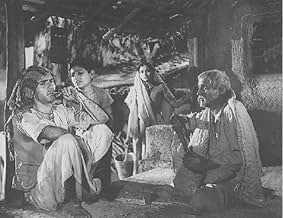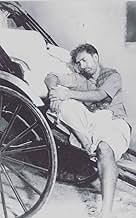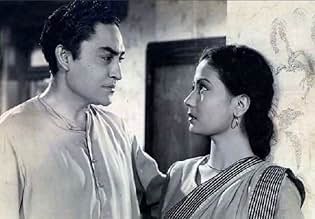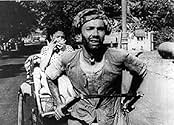IMDb-BEWERTUNG
8,3/10
2329
IHRE BEWERTUNG
Füge eine Handlung in deiner Sprache hinzuIn the hope of earning enough money to pay off his debts and save his land, a poor farmer becomes a rickshaw puller in Calcutta and faces many difficulties.In the hope of earning enough money to pay off his debts and save his land, a poor farmer becomes a rickshaw puller in Calcutta and faces many difficulties.In the hope of earning enough money to pay off his debts and save his land, a poor farmer becomes a rickshaw puller in Calcutta and faces many difficulties.
- Auszeichnungen
- 4 Gewinne & 1 Nominierung insgesamt
Ratan Kumar
- Kanhaiya Maheto
- (as Rattan Kumar)
Rajlakshmi Devi
- Nayabji
- (as Rajlakshmi)
Nasir Hussain
- Rickshaw puller
- (as Nazir Hussain)
Ramayan Tiwari
- Paro's molester
- (as Tiwari)
Handlung
WUSSTEST DU SCHON:
- WissenswertesWhen the shoeshine boys discuss seeing Nargis in Awara - Der Vagabund von Bombay (1951), one of them alludes to a shirt worn by a bystander. The shirt is decorated with a recurring pattern showing the famous scene from Awara - Der Vagabund von Bombay (1951) in which Raj Kapoor comes upon Nargis as she is changing clothes, partially hidden by a screen, after swimming. That scene occupies a place in Hindi cinema comparable to that of Deborah Kerr and Burt Lancaster on the beach in Verdammt in alle Ewigkeit (1953).
- Soundtrackshariyaala saawan dhol bajaata aaya
Sung by Lata Mangeshkar, Manna Dey
Ausgewählte Rezension
After watching the Satyajit Ray films, The Apu Trilogy (1955-1959) and Devi (1960), I decided to check out some of the realistic films directed by other Bengali filmmakers during that same era. One of the films I found was Do Bigha Zamin, which won the International Prize at the 1954 Cannes Film Festival.
Although it's a Hindi-language film, and therefore technically a 'Bollywood' movie, the film's director Bimal Roy is from Bengal, thus the film has more in common with Bengali art cinema than it does with mainstream Bollywood as a result. The film does have a few musical numbers, like a lot of other Hollywood and Bollywood movies of that era, but what sets Do Bigha Zamin apart is its greater sense of realism. Beyond the few musical numbers, the film itself doesn't have much melodrama to it and there isn't much of a background score either, which is a good thing to me as a sappy or sentimental score isn't necessary for a film like this.
Do Bigha Zamin is very much a character-driven drama and the actors did a great job in portraying their respective characters. The performances which stand out most are Balraj Sahni as the farmer Shambu, the protagonist of the story, and the child actor Rattan Kumar as his son Kanhaiya. Nirupa Roy also gave a very good performance as Shambu's wife Paro.
As for Bimal Roy's direction, the film has one of the best depictions of poverty I've ever seen, covering both rural poverty in a Bengali village and urban poverty in Calcutta (now Kolkata), including the plight of street kids living in the city's slums. The film's ending was also powerful and it was overall a very moving film.
8/10
Although it's a Hindi-language film, and therefore technically a 'Bollywood' movie, the film's director Bimal Roy is from Bengal, thus the film has more in common with Bengali art cinema than it does with mainstream Bollywood as a result. The film does have a few musical numbers, like a lot of other Hollywood and Bollywood movies of that era, but what sets Do Bigha Zamin apart is its greater sense of realism. Beyond the few musical numbers, the film itself doesn't have much melodrama to it and there isn't much of a background score either, which is a good thing to me as a sappy or sentimental score isn't necessary for a film like this.
Do Bigha Zamin is very much a character-driven drama and the actors did a great job in portraying their respective characters. The performances which stand out most are Balraj Sahni as the farmer Shambu, the protagonist of the story, and the child actor Rattan Kumar as his son Kanhaiya. Nirupa Roy also gave a very good performance as Shambu's wife Paro.
As for Bimal Roy's direction, the film has one of the best depictions of poverty I've ever seen, covering both rural poverty in a Bengali village and urban poverty in Calcutta (now Kolkata), including the plight of street kids living in the city's slums. The film's ending was also powerful and it was overall a very moving film.
8/10
Top-Auswahl
Melde dich zum Bewerten an und greife auf die Watchlist für personalisierte Empfehlungen zu.
- How long is Do Bigha Zamin?Powered by Alexa
Details
- Laufzeit2 Stunden 11 Minuten
- Farbe
- Seitenverhältnis
- 1.37 : 1
Zu dieser Seite beitragen
Bearbeitung vorschlagen oder fehlenden Inhalt hinzufügen

Oberste Lücke
By what name was Zwei Hektar Land (1953) officially released in Canada in English?
Antwort



























